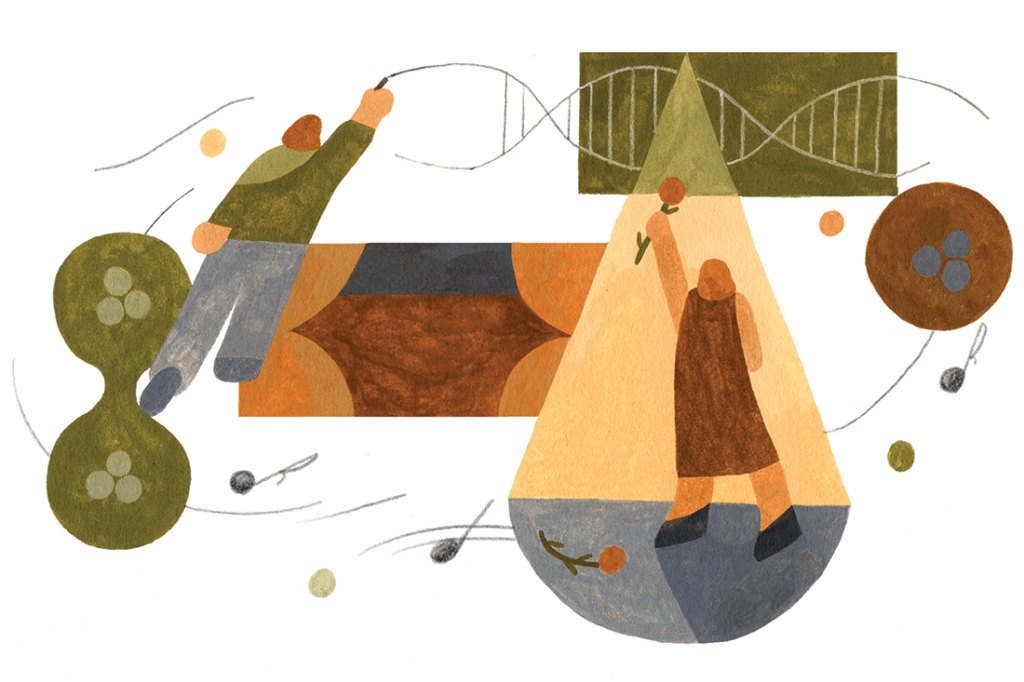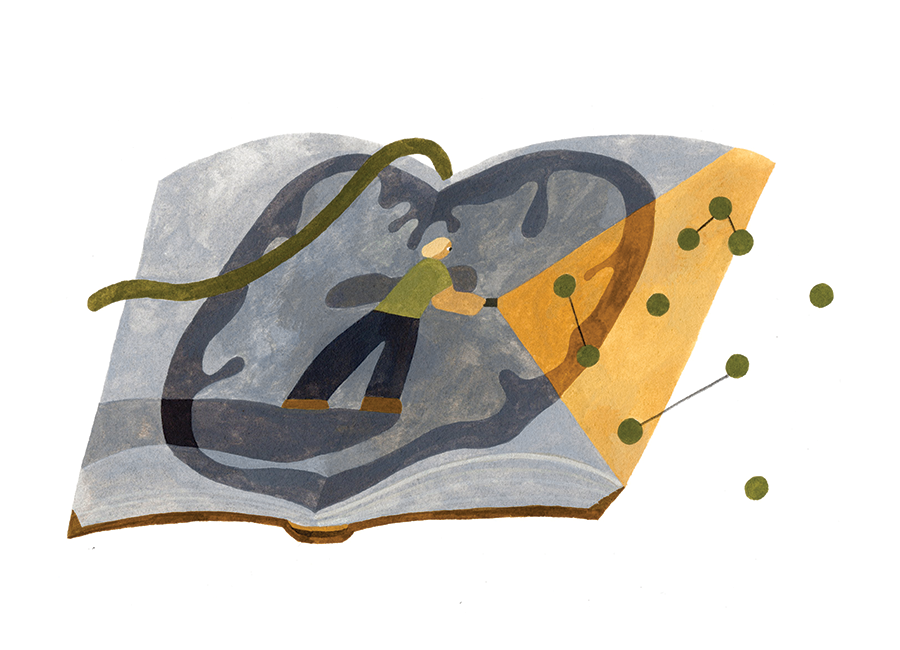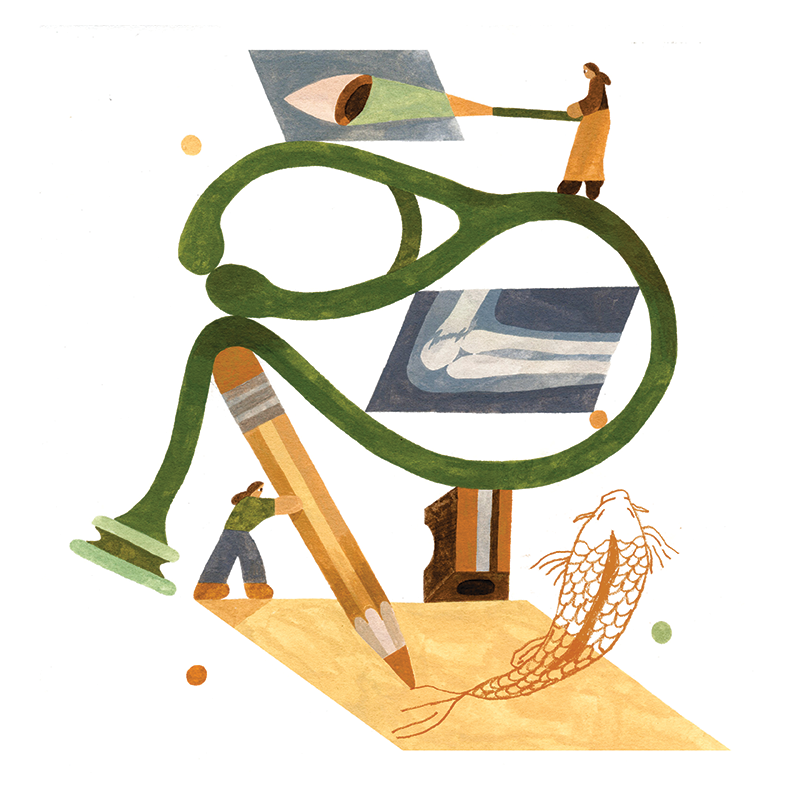Story by Sharon Aschaiek
Artistic expression has long been known to benefit our well-being, productivity and relationships.
Here, three members of the Temerty Medicine community share what art-making brings to their lives.

Zoe Clarke
PhD Candidate, Computational Biology in Molecular Genetics
What do studying cancer in woodchucks and singing opera arias have in common? More than you might think, says Zoe Clarke, a part-time mezzo-soprano who says her work on the stage bolsters her work in the lab.
At the Biological Systems Lab led by Professor Gary Bader, of the Donnelly Centre for Cellular and Biomolecular Research, Clarke is examining how liver cancer develops in groundhogs infected with hepatitis B. The work involves sequencing the rodent’s expressed genes, and using data visualization and analysis software to identify the cancer’s pathways, interactions and patterns. In May 2021, Nature Protocols published her first scientific paper. It was on best practices for annotating single-cell transcriptomic (RNA) maps.
Examining the nuances of large data sets is time-consuming, painstaking work, but Clarke has an advantage — she is used to summoning intense focus to learn songs from operas by Schubert, Mozart and Tchaikovsky (her favourite composer). This sharp focus is especially needed when she sings in languages other than English and German, in which she’s fluent. Operas in Russian, French and Italian require a careful word-by-word analysis to ensure proper pronunciation and intonation.
“Just like science, opera requires a lot of discipline,” says Clarke, who discovered her passion for the art form in Grade 11 when taking voice lessons from an opera singer. “It requires you to be very studious and dedicated.”
Clarke studied both biology and music as an undergraduate student at Queen’s University. Then in 2019, the summer after graduation, she joined other emerging artists at a six-week opera training program in Edmonton. That fall, she pivoted to computational biology, driven by her fascination with the biology of cancer, enjoyment of research and aptitude for the mathematical modelling of data.
Another opera skill she brings to her scientific work is connecting with audiences.
“The flair for performance in opera, I can see it bleeding into my scientific presentations,” she says. “I often feel like I’m performing rather than presenting because I’m so invested in how the audience is feeling … I want people to be enjoying themselves and actively interested in what I’m doing.”

Pier Bryden
Associate Dean, Clinical Affairs & Professional Values Associate Professor, Department of Psychiatry
Pier Bryden (PGME ’97 & ’01) turned to art as a way to cope with the fear and tedium of the pandemic and, as she puts it, quit her “ruminating” and “doomscrolling.” Already the co-author of two non-fiction books about psychiatry, she was drawn to historical fiction as a way to write with fewer restrictions and more creativity.
“Writing fiction would allow me to put my professional self and obligations somewhat to one side and just write a bit more selfishly and with less observance of constraints,” says Bryden, a staff psychiatrist at The Hospital for Sick Children. “I could just play and explore. It felt very freeing.”
What captured Bryden’s imagination as a subject for a fiction piece was the remarkable but little-known story of France’s first female psychiatrist, Constance Pascal. Born in Romania in 1877 and educated in medicine at the University of Paris, Pascal was the first woman in France to be appointed medical director of a psychiatric hospital. The prejudices she encountered in the all-male domain did not impede her pioneering work, which included founding one of the country’s first schools for children with severe learning difficulties, and reforming asylum practices and psychotherapeutic interventions to better reflect the social and biological causes of mental illness.
Researching and writing historical fiction about Pascal’s clinical work and personal life was, for Bryden, “utterly absorbing and fascinating.” The process became meaningful as she connected with Pascal’s granddaughter and individuals affiliated with the last asylum she had led. Pascal’s advocacy for other emerging female psychiatric nurses inspired Bryden. And she enjoyed the challenge of integrating the broader social context: extreme discrimination against women, growing far-right sentiment in Europe and the rise of eugenics in medicine.
“The work allowed me to keep my brain busy in a very constructive and enjoyable way, and I also learned a lot,” Bryden says. “It allowed me to delve into a very different world.”
A voracious reader current on the cognitive psychology literature that links engaging with narrative and greater empathy, Bryden feels certain that fiction writing has given her an edge in her psychiatry practice.
“Reading opens you up to others’ experiences in a very deep way,” she says. “It allows me to think of my patients in terms of myriad potential individual life narratives, family histories and diverse cultural backgrounds.”

Art really helps me with de-stressing and supporting my mental health. It allows me to just be present in the moment and relax
Amanda Mac
Second-year MD Student
Included in the portfolio of visual artist Amanda Mac is one of her favourite artworks, a digital painting of a koi fish swimming in a pond. Mac says that in her Buddhist culture, koi represent perseverance because of their ability to swim against the current to reach their destination.
That is useful symbolism for Mac to recall as she enters the second year of her medical education. Drawing and painting have long been joyful creative outlets for her, pursuits that have helped her successfully navigate the transition from her bachelor’s program in health sciences at the University of Ottawa to the heavier academic demands of medical school.
“I’m learning that a huge part of being in medicine is making sure that you’re taking care of yourself and building personal resilience. Before you can help others, you have to make sure you’re looking after yourself,” says Mac, who is concurrently completing Temerty Medicine’s one-year Graduate Diploma in Health Research. “Art really helps me with de-stressing and supporting my mental health. It allows me to just be present in the moment and relax.”
Mac’s diverse artworks also depict breakfast in bed, an animated jellyfish, a magical mermaid and multiple classic scenes of downtown Toronto: a streetcar with the CN Tower in the background, the Flatiron Building and the Kim’s Convenience shop of CBC sitcom fame. Entirely self-taught, she learns techniques through YouTube tutorials and creates on her tablet using software such as Sketchbook, Procreate and Adobe Fresco. She has an online shop in the global artist marketplace Redbubble where she sells her art as prints, coasters, clocks and tote bags.
Artmaking, Mac says, has equipped her with the capacity for out-of-the-box thinking that she believes will allow her to approach her medical career more dynamically.
“In art, there is no right or wrong way to do things,” she says. “I think that can be helpful when you’re speaking with a patient or working through a medical case because there are so many different factors to take into account.”
One of those key factors, she says, is the patient’s own account of their health challenges. Since Mac often takes on commissioned projects, she understands the importance of paying close attention to a client’s wishes to achieve their artistic vision and likens that process to working with a patient.
“I see medicine as a collaborative effort between the physician and patient,” she says. “It requires a lot of deep listening and back-and-forth communication.”